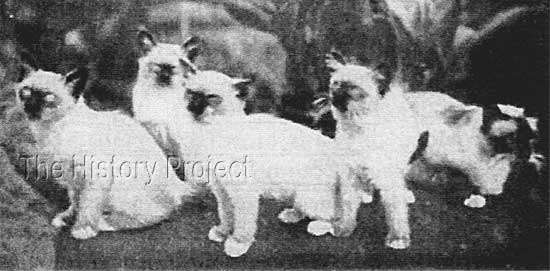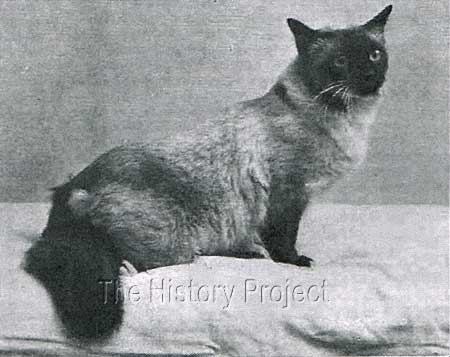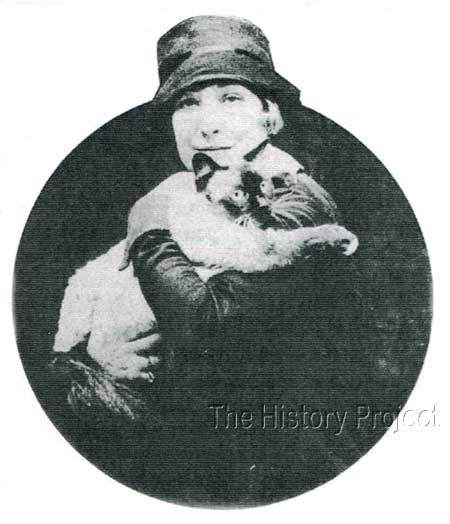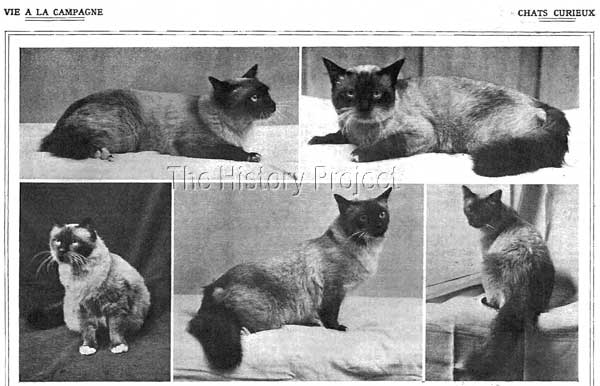 | ||||||||||||||||||









|
MANOU DE MADALPOUR (c1925)PHOTOS | SOCIAL MEDIA | REFERENCES
HISTORICAL BACKGROUND:'Manou de Madalpour, can easily claim to be the first Birman male of significance to rise out of the emerging breed, since the tragic loss of his maternal grandsire, 'Madalpour' who was the 'Pater Originale,' and one of the only two Sacred Cats of Burma of record, to journey out of their native homeland and the mystical underground temple of 'Lao Tsun'. His connection to his dam 'Poupee de Madalpour' is unquestioned, as both were shown together in Paris, where 'Poupee' had made a sensational debut as a mature female at the International Cat Show in 1926, and in the following year, was accompanied by her son 'Manou' who at that time was shown under the ownership of Madame Marcelle Adam. As a breeding cat, he was an invaluable asset, as he now represented the best so far in a male, and one of the best options for securing the future of expanding the gene pool. Simultaneously the French were developing a breed known as the 'Khmer' which was a pointed longhair coming out of a combination of Persian and Siamese bloodlines. These were, in fact, the French equivalent of what would later be known in England as the 'colourpoint'. In France, in these early days, they were referred to as "the poor man's Birman".1 PARENTAGE & OWNERSHIP:Early reports from both Dr. Jumaud and Marcelle Baudoin-Chevoisier affirmed that 'Poupee' was originally outcrossed to what was described as a 'Laotian Lynx', owned by a Doctor in Nice. This cat, it was said, resembled a 'Siamese'. But a number of years later the Swiss Siamese breeder Abbot Marcel Chamonin (who also wrote under the pseudonym of 'Marcel Reney') followed up by tracking down the Doctor in Nice and writing to him. The response was unequivocal, "We have had indeed several Siamese cats but know nothing of the origins. I know nothing of Mme Hadisch of Vienna".6
Unknown
(Laotian Lynx/Siamese)
| Unknown
Manou de Madalpour, c1925, Seal Point Birman, M
| Madalpour
CH Poupee de Madalpour
Sita (IMP Burma)
So we know that for the first breeding of 'Poupee' the outcross was likely to have been the Doctor's Siamese, which was of "unknown" ancestry, was probably shorthaired (possibly carrying long-hair) and that the first kittens were probably all short-haired.
Although it is possible that 'Manou' could have come from this particular breeding, it seems unlikely given that he was a semi-longhair. It is more likely, that he was produced from another descendant of 'Poupee' bred back to her. (possibly as late as 1925). It is equally possible that the dam of 'Poupee' may have been bred again, to an outcross, and that there were eventually other options for 'Poupee' within two to three years. Quoting from Simone Poirier who is referring to an article by Marcel Baudoin-Crevoisier: "Marcel Baudoin wrote that 'Poupee de Madalpour' had been mated to a Siamese with very blue eyes accordingly named 'the cat of Laos' belonging to a doctor in Nice. Then, by successive crosses (but he does not say with what breed), the breeders were finally able to obtain a cat as beautiful as its mother 'Poupee': the famous MANOU of Mme Marcel Adam."1 The term 'successive crosses' may be interpreted a number of ways. It could mean repeats of the same breedings, or a collection of breedings between resultant and alternative outcrosses! Regardless, the end result was 'Manou de Madalpour' and he was considered to be an absolute triumph against odds. The ownership of 'Manou de Madalpour' is clearly indicated in the captions to his photographs published in Vie A La Campagne. This was Madame Marcelle Adam. But we learn more about this lady from Simone Poirier in Les Secrets du Chat Sacré de Birmanie (Secrets of the Sacred Cat of Burma) which she co-authored with Gisele Barnay, an English translation of which was subsequently produced by Alwyn Hill. In it, Poirier reveals: "Marcelle Adam was a novelist of the twenties, a contemporary of Collette. She had written Moune, Femme d'artiste (Moune, the Artist's Woman) but her name was mainly linked with the promotion of the Birman cat. At the cat show the following year (1927), she showed a superb male Birman who belonged to her: Manou de Madalpour."1 SIBLINGS & SHOWS:Although we cannot know for a certainly whether the following were from a repeat of the breeding which successfully produced 'Manou' we do know that these kittens were at least his half -siblings, being the direct progeny of 'Poupee de Madalpour'. Simone Poirier affirms: "In 1926-27 'Poupee' gave birth to other kittens with fairly good gloves: the male kittens 'Sinh' and 'Lon Golden' and the females 'Sita II' (named after Poupee's mother Sita) and 'Nafaghi' amongst others."1
By adding "..amongst others", we are left to expect that there may have been more, which are not listed or named specifically. Hence 'Manou' had a number of at least 'dam-siblings' and some may indeed have been full siblings. Shows: Manou made his show debut in 1926, gaining a first at Paris. We find a wealth of information about those specific shows and also about a critical show which followed in 1928 in a published conversation between Simone Poirier and Giselle Barnay from Les Secrets du Chat Sacré de Birmanie1:
GB: "A single Birman competed, effectively, at this show. There were comments in the papers of the time. 'It is unfortunate that this pretty breed has not expanded further. However it did not exist until a few years ago in France. The Birman coat and his qualities have to be the same as the Siamese: light colour coat, a distinctive mask of otter-brown and with beautiful blue eyes, but where the Siamese have short fur, that of the Birman is long and their four paws are gloved in white." BREEDING & PROGENY:Although there are no official records proving progeny of Manou de Madalpour, it seems very likely that there could have been a good number. But unfortunately none have been found and there are no records available to show that Mme Marcelle Adams bred any, or of other breeders, such as Mme Leotardi, who owned his dam 'Poupee' having made use of him at stud. And even more notably, not even Marcel Baudoin-Chevoisier appears to have bred from him, which seems unusual given that he clearly bred from predominantly 'Madalpour' bloodlines and from various combinations of those, was able to produce the magnificent 'Dieu d'Arakan' in 1930. PHOTOS:
SOCIAL MEDIA :
In Summary: In 'Manou de Madalpour' we see the beginnings of the Birman as a breed, as a seal-point Semi-Longhair, with gloved paws. And we are indeed fortunate to be able to see photographic evidence of his existence, as published in 'Vie a La Campgne' in 1926 and 1935 respectively. These valuable and informative photographs were taken at the exhibitions he attended; including when, as the sole representative example of this rare breed he was displayed alongside incense sticks and a bronze Buddha!, by Madame Marcel Adam in Central Feline Society show in 1927. Gisele Barnay referred to this incident when she humorously questioned Simone Poirier decades later about when the latter exhibited her own 'Cosima de Muses' in 1953. Barnay asked: "Did you place a bronze Buddha and incense sticks in your cages, like Marcelle Adam did in 1927?" Poirier responded: "No! Madame Ravel never accepted decorated cages. All the cats had to be impersonal. She only allowed white linings and she was right: it was much more harmonious.""1 'Manou' remains the earliest example we find of an actual Birman male, unique as direct long-haired descendant of his grandsire 'Madalpour'; bridging the gap between his pure Birman progenitor and the arrival of 'Dieu d'Arakan' only five years later. In being able to see and assess him visually, we can get a clear impression of the progress made between 1920 and 1930, and the amazing transformation that took place in what was the principal re-development of this exciting and emerging breed. REFERENCES:
Registers associated with this article include The Incorporated Cat Fanciers Association of Great Britain (TICFAGB), National Cat Club (NCC), The Cat Club (CCR), Beresford Cat Club (BCC), Feline Federation Francaise (FFF), Siamese Cat Registry (SCR), US Register & Studbook for Cats (USR)including Supplement(USRS), The Studbook of the American Cat Association (ACA), and the Studbook & Register of the Cat Fanciers' Association (CFA).
|
|||||||||||||||||
Home | Cats | Gallery | Clubs | People | Artifacts | Articles | Updates | Contact Us ©The CFA Foundation, Inc and The Harrison Weir Collection
|
||||||||||||||||||







